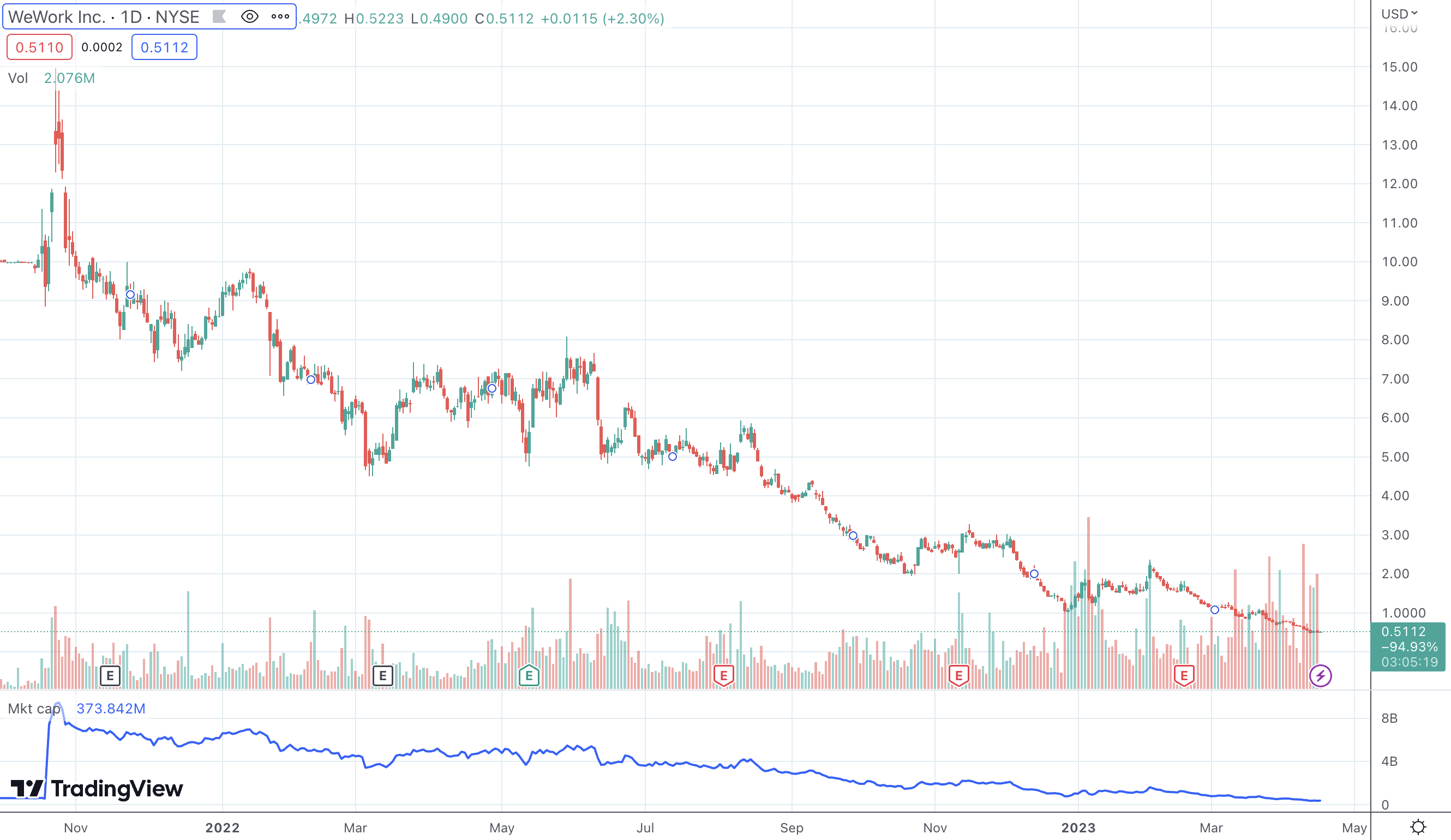
The past ~3 years of SPAC-mania – high-growth businesses rushing to the public markets with overzealous valuations by merging with one of the 100s of blank-check companies, aka special purpose acquisition companies (or SPACs), that came to market in 2021 – is seeing its final act.
The growth-at-all-costs innovation model (aggressive market share expansion at the expense of profitability) that had provided tech startups with the resources to disrupt a sector virtually overnight (e.g. Uber, Airbnb, Netflix, Procore, etc.) is no longer a viable option.
The chickens are coming home to roost for many of those built-world startups that opted to take their companies public via SPAC before they were ready in the easy-money markets of 2021 & early-2022.
Let's examine 4 stocks' in the built environment that are at risk of delisting after their untraditional entry into the public domain.
Built World Stocks At Risk Delisting


WeWork (WE), the shared office space pioneer which unfoundedly scored a $47B valuation from Softbank’s Masayoshi Son (whose reputation as an investing genius has since reversed to the "worst investor ever") at the start of 2019, is now trading at that lofty price tag (~$350M market cap - its public market valuation).
WeWork’s seen its financial position go from bad to worse since its failed IPO in 2019 – investment bankers deflating the frothy valuation (to say the least) of WeWork’s “tech company" postulation, claiming it's little more than an over-leveraged commercial real estate company.
WeWork limped into the public market via SPAC in 2021 at a less than $10B valuation and has since been hemorrhaging cash alongside its dive-bombing stock price. Having surrendered more than $1B in losses last year, few signs of near-term profitability, disintegrating liquidity ($287M in cash & equivalents and falling), and increasingly limited access to capital, the market is pricing WeWork for a default (trading <1x price-to-current assets).
WeWork received a non-compliance notice from the NYSE last Tuesday with its share price below $1 for 30 consecutive trading days, putting it at risk of delisting if it is unable to regain compliance (get its share price above $1) within the next 6 months.
In this rapidly tightening credit environment, I would be surprised if WeWork, who’s already leveraging $3.2B in debt, survived the next 6 months without a serious restructuring.

Latch (LTCH), a smart-lock PropTech company, was officially set to delist from the NASDAQ exchange this past February in the wake of some controversial accounting inaccuracies, with the rapidly deteriorating health of its balance sheet providing little help. The company has managed to buy itself some time with the recent compliance extension but will need to quickly reconcile its faulty accounting metrics before it's considered a viable investment.
Latch reached the public market in June of 2021 at a market valuation of $1.56B through a SPAC backed by Tishman Speyer and LTCH is now valued at less than $100M.
Latch has laid off 63% of its employees in the past 12 months as it leans up operations and looks to stay above water long enough to reconcile its accounting discrepancies and reach a degree of operational profitability.

View (VIEW), another Softbank disaster, is trading at just 3% of the valuation it was able to secure when it publicized its shares (via SPAC-merger) less than 2 years ago.
View Inc. has seen over $2.5B in VC funding, in addition to the rescue round of $200M in October 2022, but only holds a $90M market cap. This "smart window" innovator can't seem to find the near-term economies of scale required to keep this business from running into the imminent capital crisis it looks to be headed towards.
In 2022, View's operational losses more than tripled its revenue, which only grew by 36.5% from the year prior. Debt is compounding, while its cash and cash equivalent liquidity levels dwindle down towards $0 (expected Q1 loss matching View's cash balances as of the end of 2022).
VIEW is at immediate risk of being delisted, with the end of May marking the NASDAQ's deadline for View to get its already delayed Q1 results out to investors/regulators.

Matterport (MTTR) is trading at less than a 10th of what it was 18 months ago, with profitability remaining a distant thought, and hoping to maintain operations through the continued sale of its deteriorating shares.
Operationally speaking, Matterport looks a bit better than some of its over-leveraged cohorts with no debt in the books and enough balance sheet liquidity (cash & equivalents) to continue at this >$100M annual deficit for the next few years.
However, the company's current inability to achieve the escape velocity of subscription growth it needs for a clear path to profitability is a significant concern for MTTR's investor community. Management dropped its forward-looking Q1 guidance to ~0%, a growth metric that continues to run out of steam.
MTTR isn't at immediate risk of delisting but it is definitely one to watch as it looks to reaccelerate demand for its ARR-driving (annual recurring revenue) subscription offering.


Discussion
Be the first to leave a comment.
You must be a member of the BuiltWorlds community to join the discussion.